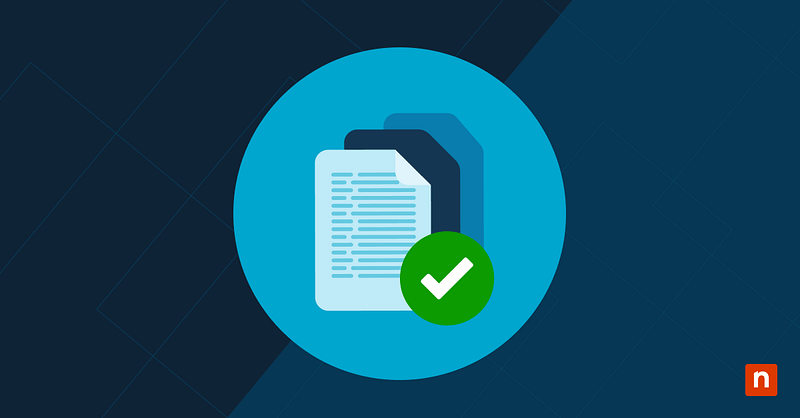Archiving legal files is a key task for IT departments and managed service providers (MSPs) that manage and protect data for law firms. Legal documentation such as contracts, communication, case files, and court records must be held in compliance with industry standards; including strict retention, chain-of-custody, and auditing requirements.
This guide explains the backup and archiving for secure legal documentation that you can implement for business data backup in the legal industry. These solutions include functionality that helps you meet common requirements for keeping and archiving legal documents, including maintaining the integrity, security, and long-term availability of law firms’ data.
What is the best way to keep legal documents?
Law firms and businesses handling legal documents, or working in compliance-driven industries (including MSPs that manage the IT infrastructure on behalf of these organizations), must fully understand the legally enforced measures they must take to protect data, including backup and archiving.
This must include consulting with legal professionals who fully understand the processes and measures that must be implemented, as well as technical experts to implement the technologies required. This is vital as failure to comply with these regulations can lead to penalties; for example, law firms are accountable in the US for the spoliation of evidence.
While backup and data disaster recovery are a necessity for business continuity and should be implemented by every organization to protect data and infrastructure, additional regulations in the legal industry may stipulate additional measures, such as:
- Data retention: Legal data is often required to remain accessible and immutable for years or decades
- Versioned backups: May be required for compliance or legal defensibility as well as disaster recovery
- WORM storage, legal hold, and chain-of-custody: “Write once, read many” and preserving data so that it cannot be tampered with, while fully auditing all access and changes to all files (including emails and communications) is a common requirement
- Support standardized formats: Archives need to be kept or exportable in a format that is readable outside their native environment (e.g., PDF)
Understanding legal backup vs. archiving
Backup and archiving are intertwined IT concepts that rely on many of the same technologies, but that serve distinct purposes.
| Function | Backup | Archiving |
|---|---|---|
| Purpose | Operational resilience, disaster recovery, and rapid restore | Long-term preservation, discovery, and other legal and regulatory requirements |
| Retention Focus | Short to medium term (30-180 days) | Long-term (years or indefinite) |
| Storage Format | Compressed or encrypted | Indexed, immutable |
| Search Functionality | Limited or folder-level | Granular (full-text, metadata) |
| Legal Hold Support | No | Yes |
| Audit Trails | Basic or none | Detailed chain-of-custody logging |
While they benefit from a unified solution, backup and archiving must be treated separately to ensure the best practices of each are fully met.
Data backup for law firms
All businesses need robust backup solutions, especially those handling personal information, in accordance with privacy frameworks like GDPR and CCPA. This isn’t just for compliance: it also protects against data loss from theft, damaged devices, and accidental deletion, as well as cybersecurity threats.
Legal firms are a popular target for hackers and ransomware, making an effective backup strategy essential. Law firms will have additional backup requirements that may extend beyond other businesses for operational and compliance reasons, including:
- Snapshot-based, scheduled daily backups of legal case data
- The inclusion of data from documentation systems (iManage, NetDocuments), and other specialized software
- The encryption of data in transit and at rest
- Redundancy backups stored in multiple off-site locations and in the cloud
Using snapshot-based backups can meet compliance goals by ensuring that all previous versions of files are available for the time they are retained (usually 30-90 days minimum). Backups should be regularly validated by restoring them in a test environment and ensuring that they are readable and usable.
Cloud backup for law firms
Cloud backup is a popular solution that, when used properly, can help ensure the integrity and longevity of backups and archives for law firms. You must, however, ensure that you retain your own copies of files, and that your chosen cloud providers are fully compliant with the same regulations that cover your organization.
Archiving legal files
There are several key processes that you can enact to comply with legal archiving requirements beyond what you need to do for backing up the same data:
- Ensure that the mandated archiving formats are supported, for example, PDF/A, PST, and MSG, and that metadata is preserved
- Index the full text and metadata of archived documents for search and discovery
- Capture and store documents and emails in tamper-proof (WORM) formats
- Prevent relevant communications from being deleted or tampered with during litigation using legal holds
You should keep archived legal data well organized (classified, based on client, case, or matter) so that it can be readily found, and properly protected or updated if necessary. All personal data and sensitive information should be secured using role-based access (recognizing the principle of least privilege) that is fully audited, and retained using schedules that align with state bar rules, court mandates, or other internal policies.
Meeting the legal requirements for archiving legal files and data protection can be enabled and enforced using compliant automated backup solutions.
Email archiving for law firms: eDiscovery and legal hold
Legal holds (or litigation holds) are a feature of most enterprise-grade email hosting platforms (including Microsoft 365 and Google Workspace). When a legal hold is in place, all covered communications are preserved so that they cannot be deleted or tampered with.
eDiscovery is another feature common to enterprise communication (for example, in Purview as a part of Microsoft 365), as well as available as a third-party solution, that makes communications searchable with tagging and export options for legal or regulatory purposes. It is critical for businesses operating in the legal industry to choose platforms that natively support litigation features, to reduce the work required to implement them, and ensure compliance.
Automated email archiving should be implemented to ensure that access to communications records is not disrupted by service outages or other technical issues.
The best solution for business data backup is the one that meets all your security and compliance requirements
Every business has established its own efficient processes and operates in a unique legal environment. Industry standards such as SOC 2, ISO 27001, and ABA Model Rules 1.6 for confidentiality must be implemented, without hindering the day-to-day business operations of law firms. Detailed audit trails must be kept for all access and recovery activities, and backups and archives must be stored across on-site and cloud locations for redundancy. In some cases, data sovereignty and additional legal requirements may be necessary.
Keeping on top of the growing number of requirements for securing legal documentation is a significant task for IT teams of any size, especially for MSPs serving multiple clients. In addition to meeting ongoing infrastructure and operational obligations, IT administrators must keep stakeholders up-to-date, while data must be continuously reviewed and purged according to defined schedules.
Choosing a Unified Endpoint Management (UEM) and IT management like NinjaOne gives you full flexibility for implementing business backup and archiving, automating the process, and maintaining oversight and visibility. This allows you to enact a dual-layer backup and archiving strategy that fully meets the obligations of each, allowing for disaster recovery while meeting legal discovery requirements.








